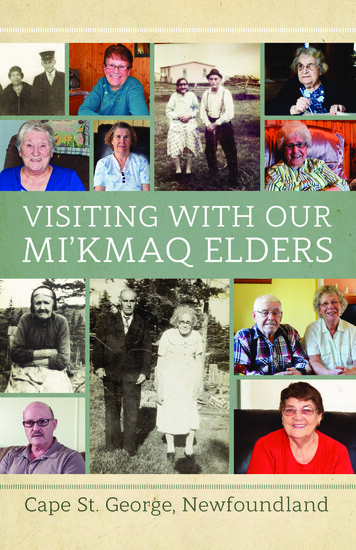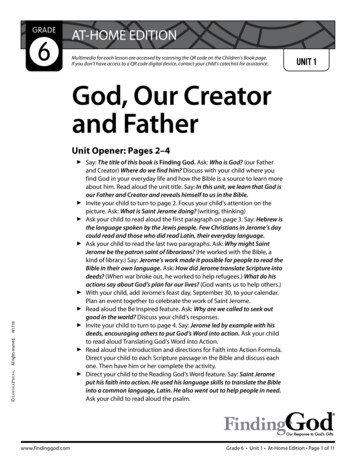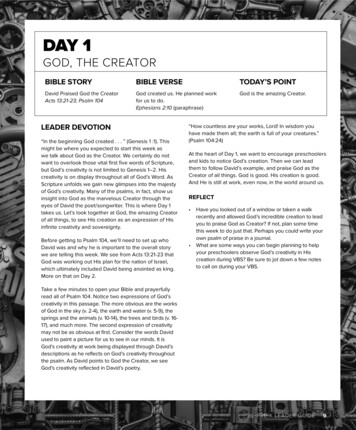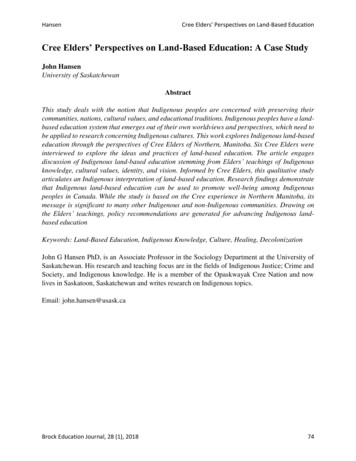
Transcription
VISITING WITH OURMI’KMAQ ELDERSCape St. George, NewfoundlandBENOIT FIR ST NAT ION2016
T HIS PRO JECT WA S F UNDED BY T HE DEPARTMEN T OFBUSINE SS, TOUR ISM, CULTUR E AND RUR A L DEVELOPMEN T,OF NEWFOUNDL AND A ND L AB R AD OR .
INTRODUCTIONCape St George is unique in many ways. It has been isolatedfrom the rest of Newfoundland for so long that it has a veryunique cultural identity. In a time when the rest of westernNewfoundland was being assimilated into English Newfoundland culture, a few communities on the end of the Portau Port peninsula held onto their culture and language. Alas,the French barely held on and the Mi’kmaq language all butdisappeared. The cultural identity, however, remained.Sometimes I feel like an outsider in this community. Myroots don’t go very deep as my parents migrated here in the latesixties. However the people of this town have always made mefeel welcome. So mine is in some a sense an objective point ofview. This perspective may have helped me in my search forthe Mi’kmaq story.Cape St George has two strong cultural identities: Nativeand French. I too share these identities with a certain precariousness: I am French but I am neither Acadian nor of directFrench descent: my ancestors are from Quebec. I am nativebut I am not Mi’kmaq but Mohawk. So in a sense I fit into the local cultural landscape as I am part Native and partVISITING OUR MI ’KMAQ ELDER S 03
French and in another sense I am doomed to be an outsider inmy home town.One thing I did discover as I interviewed the fascinatingMi’kmaq elders of Cape St George is that there is a richnessof tradition here that transcends the polarization of culture.These people had a common struggle that dictated the shapeof their daily routine: survival. Many of their memories aredramatic in that they were taught to survive in a harsh demanding isolated environment with little help from the outside world. In a way this isolation preserved some of theircultural identity.Ultimately everyone I talked to did not share my pointof view. I was not considered an outsider by anyone and waswelcomed with warmth and kindness. They were willing totrust me with their stories and I hope that I merit that trust.I certainly feel that I have gained an appreciation of their history and tradition.In this booklet we have scratched the surface of the richhistory and culture that surrounds this area. The men andwomen that have revealed a glimpse of what it was and is to beMi’kmaq in Cape St George have invited you to experience asmall part of their experience. I hope you enjoy.MICHAEL FEN WICKBenoit 1st Nation Héritage Program
AGATHA M JESSOI lived in red brook. All mylife.My grandmother Grammy Desiree, she was Indianyeah. Run away from Nova Scotia that’s what my father toldus now. And then she come here with Uncle Joe, Uncle Mike,daddy and aunt Clemaze. That’s real Indians. Grammy Desireeshe was a real Indian. Start from there and going up. Oh I remembers going to visit Grammy Desiree and that. She was anice old woman. Yeah, I remember that.Well, my father was a fisherman and my husband was afisherman and all my brothers were fisherman, just about all ofthem. Uncle Joe had a sawmill down there in the field. Myfather had a water mill in the brook, in the dam. Yeah. Hehad a water mill. Sawing logs. Now Johnny, my half-brother,Johnny he had a place there, he had a barn. We all used to goto the barn dance. You hear talks of the barn dance? They allplayed the music, accordion, violins and everything, the wholeworks of them.Oh Grandma Desiree she was a real Indian, her. Oh myVISITING OUR MI ’KMAQ ELDER S 05
gosh, well, she reared up all herchildren when she got here, soI guess there wasn’t very muchfor her to do. She only had asmall little house. That’s all Iremembers. Can’t remembertoo much back.She cooked seal meat andrabbits, plant her own vegetables. They had their own meat.They lived from the sea andthe land. Their own vegetablesfrom their own gardens. Andown meat: sheep, cattle. Oh yesskin the rabbits and knit andeverything, card your wool andMICHEL “MIC” BENOIT AND BIG ANNIE MOSESthen spin your wool.Uncle Joe had a mill downhere, that’s all I knows. He had cattle a farm, not really a farmbut he had cattle enough to live off of. Vegetables, and all that.Cattle and horses.My father was Johnny Mic and then my Uncle Joe Mic,Mike Mick, they were called Mics. (Why were they called that)I don’t know. I don’t know it was background or what or wasGrammy Desiree. They was micks anyhow. Well that was it,that’s what he was called Johnny mick. Joe Mick didn’t seemto mind that he was called that. Everybody, Uncle Johnny mickthey used to call my father. Uncle Joe Mick. Micks.The old Indian ways was, I think, the best ways. Well, theywere planting their gardens. There was no The ground wasgood, the sea was good. There was no chemicals or nothing atall. Put out their own vegetables and everything. The water was
clean and the land was clean. But now the water is no good andthe land is now no good. Longtime ago you just dig a little placeto put your potatoes in and carry your potatoes in your arm.But now. Everything’s gone. They lived better. There was nosuch thing as sickness, people getting sick and cancer or nothing like that one time ago. Very seldom one would die. Nowthey’re dying every minute cause everything is polluted. Wateris polluted and the land is runned out. Too much insects now.Picking berries in the woods. Raspberries, squash berries,lots of it before the moose come. When the moose come themoose clean it off. You go in the woods all day picking berries.Everything was cleanCod fish, halibut, name it, name it you get it in the water.Cod fish, halibut, squids, lots of it, lump fish, now, no more ofthat now. All the good stuff is gone. You don’t know what toeat now.VISITING OUR MI ’KMAQ ELDER S 07
ANGELA CHAISSONMy name is Angela SimonChaisson. Two names. I grewup in Cape St George.I remembers grandmaCormier I guess, she was Indian. I remember her mother but Iwas only about three years old, so not very old when she passedaway. I didn’t really know great grandmother. But I rememberthe old lady. Grandmother Cormier’s mother.She was a Chaisson. Mom is Indian so am I. Mom’s momis Indian. Because her mother is Genevieve Benoit, right. Shemarried grandmother Cormier’s father. Before that grandmother Genevieve Benoit was married to a Chaisson, right? Ithink so cause grandmother was a Chaisson. She was a Chaisson and then she married Johnny Alfred Cormier, my grandfather mom’s mother and father. She was a Cormier then andas far as I know she was Indian ‘cause mom told us they wereIndians. But we weren’t allowed to say those days that we wereIndians. I don’t understand why today they want to be Indians,right? In those days, no, we’re not Indians. And dad was Frenchof course so we’re half and half.
Grandmother liked music. She loved music and she loved tosing. And she’d make the children dance. And you know Victor Cormier and Jack Cormier? She taught them how to playthe accordion. She used to sing and she’d make them play it andthey would play and if it was wrong they had to do it again. Andshe used to make us dance. She’d make horrible music and she’dmake them dance and Jack and Victor had to learn and that wasit. Because Uncle Charlie used to play a little and she made thekids learn and it was traditional with her, the music was veryimportant. And she could dance like you’d never believe. Oh Iremember that. Dance? Oh unbelievable. She was very good.She really could dance. Something like the step dancing. Geton the floor, boy, and the music be on and she wouldn’t stop‘til the music stopped. She would dance and dance and dance.Her birthday is sept 8 same as me, I was born on her day. Onher birthday she danced and she died a few weeks after. She was87 years old. And she danced for them on her birthday. Andshe got out there and Victor, victor was her favorite, he playedfor her and she danced for him. They wanted her to dance andshe would not unless Victor comes and plays. Victor come andplayed for her and she danced.This was a big thing for us knowing that grandmother atthat age wanted to do that on her birthday. I always wanted tosee her on her birthday- it was her day, my day. Yeah. That wasgrandmother Cormier. I got her picture here she’s truly Indian.I left home, I was young, I was about 27 years old. So shepassed away when I was gone. But she was always good to us.She fed us. We were very poor off those days. We’d go there andwe always had a piece of bread and molasses. She fed the kidsand all these things, she always did nice things. But as far as Indian things, I don’t remember anybody being too much into it.Every generation has got one called Angela. As far as IVISITING OUR MI ’KMAQ ELDER S 09
know from her. Yeah her name is Angela. Then she had adaughter Angela, mom had me Angela, Joe Demer got oneAngelique, that’s Angela and there’s more. Got all the waydown the generations. She had one called after her. Her namethey used to call her Angeline, that’s French cause her husbandwas French. She spoke French too. They didn’t speak Indianthough. Not as far as I can remember they always spokeFrench.Yeah, she was a nice old lady grandmother.She used to boil roots. She go in the woods and she’d comehome with some roots from the trees and boil that. She’d giveit to the kids and she’d drink it herself. It’s really good for you.She would give mom a bottle every year. She’d do that beforethe winter. We had to get treated with all this medicine and itwas weird, ughh, it was terrible. But we had to drink it. Shebelieve in the roots from the trees.She picked everything. She picked red current, blackcurrent and she’d make something out of that. That was herfavourite. We didn’t bother with that but she did. Yeah sheused to go in the woods and get all her roots. She had a specialname for it, what it was, I don’t know, but she knew what shewas doing. So that was an Indian thing. To go out and getroots and boil it and she made medicine out of it.I remember her brother was called Narcisse Chaisson.They were Chaissons see she was married to the Chaissons.Uncle Narcisse he used to be her brother but he moved out tomainland so we never got to know him too much but we knowsome of the kids. She had a brother called Julian. Yeah anotherone there. They’re all gone of course but she had lots of sistersright. Big family really. I think we counted them one day. Allsisters - there was only two brothers: Uncle Narcisse and uncleJulien. But the rest was all sisters: like old Joe Lainey’s wife
Julia, and Uncle AdolphSimon’s wife Cicely.Her name was Ceceliabut they called her Cecily. And in MarchesPoint, Alfred Marcheswife Aunt Maggie, AuntMelina, Aunt Justineand Catherine was thefunniest one of them all.She was funny. Married in Sheaves Cove toAngus Young I think.There was one auntJarmine married nearStephenville Crossing,what they call it, notreally there, between ANGELA CHAISSON AND JOHN ALFRED CORMIERStephenville and Corner Brook? She lived there.There was a lot of girls. Yeah a lot of girls like mom evenhad more girls than boys. But she never had that many children, grandmother Cormier, who only had Uncle Charlie oneboy, and she had Aunt Eunice, mom, Aunt Bridget, Aunt Noraand Angela. I think five girls. That’s all she had six. All girlsonly one boy. See she never had a big family. They were married 9 years before they had children. She was quite the lady.Now grandmother Genevieve they called her, grandmotherGenevieve Benoit. Well she was married to grandfather Victor they were mom’s grandparents. My grandmother’s parents.I didn’t know her. I was too small to remember her.I remember when she died. I was small but I rememberthem building the coffin. Dad was one that made it, him andVISITING OUR MI ’KMAQ ELDER S 11
grandfather Cormier. You are small but you remember certain things. And I remember being at mom’s, they called herGinny, Grammy Ginny’s gone. She was pure native. She wasa Benoit to begin with. No I don’t remember anything abouther. No. Mom said she was a nice lady. Mom always thoughtthe world of her. Very nice. She was living at Uncle Charlie’shouse like you know she was living with them when she passedaway at the end of the Cape. That’s all I remember as a child.I can’t remember what she looked like. Too small I guess. Weweren’t allowed to go out there, we were too tiny to go.
CONRAD BENOITMy name is Conrad Benoit,a resident of Campbell’sCreek in the Port au Portpeninsula. I was originallyfrom Cape St George. Grew up in a little community calledLoretto, which was way off the beaten path of the main dragabout maybe about three, four miles back in the country. That’sabout where I grew up.I was about five, I suppose, when my father said to me thisday, he says, “you know” he said “you’re Indian, eh?” I said, “Isthat your polite way in telling me I’m a savage?” “No,” he said”You’re an Indian.” I said “Oh. How come this is the first timeI’m hearing of this?” “ Yes,” he said “you’re Indian. My grandmother,” he said “was a full breed Mi’kmaq Indian. GrammyDesiree Benoit.But that was the first inkling I heard of being aboriginal.People were getting sick, of course, dehydrated some of themor malnutrition or whatever depending. And then they had thisstuff called beef iron wine. But whenever that would run outdad‘d make his own stuff. He’d get dogwood rind and cherryVISITING OUR MI ’KMAQ ELDER S 13
tree rind and boil it onthe stove and the juicefrom that he’d giveus that to drink andthat would build upour immune system orwhatever. At that timethere used to be boils,and the only way theycould get rid of thatwas with a poultice. Itwas done with breadand hot water. They’dboil the water hot as itDESIREE “GRAMMY DESIREE” BENOITcould be, they’d pour iton that bread and they’d stick in on there and buddy the nextday that was gone. It would draw the infection out and a coupledays later it was gone. I remember one time dad had a bad cut onhis hand right and he went in the woods and he got them littlesaps of the trees, like gum and he took it and put it all aroundand sealed off where the cut was. Four days later the mark wasthere but it was cured. It was amazing. I guess we didn’t realizeit at the time but that would seal off the infection so it gave ita chance to heal. Cause your body would heal naturally anyway right. But yes that was some of the things that I rememberfrom back then and I don’t know where they got it from, soit had to be from his mother who was aboriginal. I mean youdo as you see, right, pretty much, so I mean it was that kind ofstuff Other than that there was no aboriginal language assuch spoke. They were French, my parents were French so theyspoke French most of the time. But I didn’t learn any of theFrench, all I learnt was English, right. Because we weren’t sup-
posed to speak French because we were going to English school,so we had to learn English. So by the time I got to grade nine Ididn’t know no French and it was too late then to start learningFrench, right. So I kind of got robbed both ways, pretty much.Well, we grew up pretty much off the land. My fatherfarmed a lot so we had a lot of animals. We grew our own vegetables, all that kind of stuff. Of course as I said farming and thestuff that dad did when I was growing up. If you wanted a raketo rake hay, you better have some tools to be able to make that,because you weren’t going to Canadian tire and buy it, becausethere was no such thing then, right. So you made all these rakes,you made all these pitchforks with wood. It was amazing to seeit. And then their rigs and racks, hay racks and stuff like that,but I mean that is I think is European. That’s nothing to dowith the aboriginal way, right.Mom always did cook. She cooked chicken and that kindof stuff and like I said, we lived off the land. We raised cattle.We salted stuff and she cooked it with vegetables and that kindof stuff, right. They had the basic stuff like flour and stuff thatyou buy, that you couldn’t grow here. They‘d bring it in withAbbotts store right on Port au Port. I remember, they had togo by boat down there cause there wasn’t even any road here onthe peninsula. Go down by boat and bring in your supplies inthe fall for the winter months. She used to make bread on thestove, little pieces of dough and throw it on the stove. Used tobe almost like a bannock type thing. I remember that clearlybecause she used to do that a lot. Especially when she’d havesome dough left over, she’d throw it on the hot stove and let itcook like that and flip it upside down. It was some good. LikeToutons. They did it in a different way, right, cause they fried itin fat then with pork in the frying pan. That was toutons. Butbefore we did that I remembers mom putting it right on theVISITING OUR MI ’KMAQ ELDER S 15
stove, taking the bread and putting it on the stove letting it cookand flipping it over and that was good.I remember they used to in the winter time they would takemeat and put it into a burlap bag, a potato bag and tie a stringon it and put it in cold water and keep it fresh in a stream. Iremember we used to have to go get water at that time too.We used to have outside wells. We used to go with our littlepails to go get water. I don’t know if that’s aboriginal, I thinkit’s more European. I remember we used to salt stuff. Likefish, salt fish. And salt meat, to cure it. I remember we usedto make cellars. Dad used to have a big cellar. Used to put itunderground and of course the frost wouldn’t get at it. Right.And there used to be a wood lid on top of that. Potatoes lastthere all winter, never had a problem. They grow the eyes andthat eventually but they were good, they were alright. And inthe spring, what was left it was the seed to plant. And it wasa continuous thing, right. Dad always had lots of vegetables:I remember him growing peas, carrot, turnip, cabbage, potatoand parsnip. What else? I think that was all the vegetablesthey could plant back then.It’s just like the hay in the summer time. In the fall you hadto clean out the old hay from the barn and throw that on the manure. That made extra manure and that they used for growingthe vegetables. So nothing was wasted. It was a fertilizer then.It was good cause it was there, they didn’t have to go anywhereto get it, it was right in the area, you just wheelbarrowed it witha wheelbarrow to the rows of vegetables, throwed it on and thatwas the end of that. Cause where we lived to, we were about,must have been, three miles from the ocean so you couldn’t getany seaweed or nothing like that. Cause seaweed was also goodfor putting on vegetables. It just wasn’t feasible at the time. Toofar away to get it.
They did all their own knitting. They sheared all their ownsheep, they did all their own wool, they made all their own cards,spinning wheels and stuff like that. That was all homemade.There was nothing like that bought as such. And cream andstuff like that, I mean there was no separators or nothing likethat back then, they just let the milk settle and the cream wouldcome to the top and that was it, that was your cream. And if themilk was sour, they would make sour milk buns with it, eitherthat or feed it to the pigs. Cause we used to have pigs and allthat too. So pretty much nothing was wasted, everything wasused.I see pictures of my grandparents and great grandparentstoday and I know you can tell they are native, they even looknative. But no, there was no drumming or no nothing like that,but there was always music. There was always fiddle music. Especially by the time I come along they could buy guitars andstuff like that, so there always music around. Accordion musicor fiddle music and there was always a party, every weekend wasa party and that’s how I learned to step dance.I remember Victor Muise and them fellers talking aboutstuff that went on, right. He used to tell me his grandmotherused to sing songs and that, but I’d be too young to hear thatkind of stuff. There were lots of music, all kinds of music onthe go but never any drumming or nothing like that, so we werecut out of all that, pretty much. Which is kind of sad because itmakes it that much harder now for the new generation comingup. Unless they get it right from kindergarten class coming upthen they’re going to be in trouble.You could tell by their facial features as to see what nativeslooked like today. They were it. They were native, there is nodoubt about it. Especially Grammy Desiree she was wicked, shewas really pure native. And I mean I can see it in the family asVISITING OUR MI ’KMAQ ELDER S 17
you are going down the line with the darker skin. I don’t knowwho I keep after but I’m lighter. I don’t have that native colour.It doesn’t mean I’m not native. We were not shown any of thenative ways cause I guess they were so busy trying to carve outa living.But no, I don’t remember nothing native like drums. Nonever seen it. Like I said, all I seen was fiddle music and guitarmusic and step dancing and that kind of stuff right but nothingto do with drumming and such like you see today. From thetime that I can remember to the time that I grew up all I remembers is dad saying to me I was native. But that’s it. Other thanthat nothing. And I see the few medicines that they made andthe kind of stuff with the poultices and other stuff they make.Some kind of stuff with mud. I don’t know what it was but itwas muddy and that was to put on sores that would cure sores.And chicken fat was another thing. That would cure sores too.That was a home remedy. Because there was no such thing assalve. What that chicken fat would do is soften it up and giveit a chance to heal. Cause that poultice thing was passed downfrom great grandparents, right.We were told we were native but that’s all we never participated in anything that would be considered native that I knewof. Maybe there was stuff done before my time from before I amable to remember.
EDNA BENOITIt isn’t too much differentnow than it was 83 yearsago. It’s much better now,easier on us. Been throughone war. World War two, it was sad. My home was up therejust up on the hill. I was the only girl in the family. I had fourbrothersThose days if you were a native you had to keep it prettydark cause people were scared. See they couldn’t announcethey were part Indian they would be punished or somethingeh? So they had to keep everything pretty calm. We had to doour own stuff, we couldn’t go to them for anything.Dad was left all alone so he learned us all his five kidslearned us to do our knitting. We had to knit for ourselves theonly thing we come to the hard parts he’d help us. To make aliving you had to work pretty hard.I didn’t know the people that drove the Indians away andthat I didn’t know them I was too small for that, too young toknow. I think they were French or something. They came hereto fish, them, but they didn’t want the Indians around. TheyVISITING OUR MI ’KMAQ ELDER S 19
took some Indians for their wives because my grandfather hadan Indian woman. Married an Indian woman.We never went short of anything to eat and we never getcold because we had our own sheep for our own wool, and ourclothes and my dad and his friend had made us a loom. And weput wool into it and made pants for the boys, long sleeves, coats,hats and blankets for the babies. Part of that he learned from hismother. Her name was Desiree, grammy Desiree. I rememberher. She used to teach my grandfather lots of stuff, how to dothis and how to do that. They had to survive. They had to huntand stuff like that and get stuff. Some kind of birds and rabbits.They get all that in the forest, eh? Lots of berries, all kinds. Sowe kept pretty busy picking up all that. She showed us how topreserve jams for the winter.Because then once every six months it used to be a big boatwould come around the cape and used to bring all kinds of stuff.She used to order stuff for bottles for putting preserves in. Allour meat was preserved, our jams, our fishes; lots of salmon,halibut and mackerel. Cases of it. Oh yes she was the headof it grandmother. Oh yes we still do it today. If we were going to serve our chicken today, there was a certain time a yearthe chickens were big enough and the hens were cleaned andkilled. Cut them all up in bottles, she had her bottles all onthe table and we fill them up with meat and we add a little bita salt to that and boil that for four hours. And then after shescrewed them all on good and she tell us to put that aside andlisten when it’s going to be cold, it’s going to “Chut” it’s going tomake a sound. That was a day for meat. The next day probablybe fish. Grandfather had a cellar underneath his house. yougo down the stairs and there she had all kinds of bottles full ofstuff. And then the winter time comes we didn’t have to botherwith nothing like that cause we’d just go downstairs.
And our vegetables, we had our garden so we used to growour onions and our lettuce and tomatoes, potatoes, carrots andparsnips. We growed it all in the gardens. So then comes October we had to go and dig up our potatoes put them in thebasement, save them for all our winter. We had lots to eat allwinter long and then when come spring, plan again. Do thesame thing over again. So we always had lots to eat.And daddy made him a little house over the well where weused to get our water from, a hole in the ground up above in thefield, we had a shelf in there we used to keep our cream and ourbutter. Cause we were living up there and it wasn’t too far fromthe water. We had lots of stuff like that.Winter was pretty busy cause by the time we get up and wehad our breakfast, we had our cows to milk, then when the warwas on there was no school hardly. The milk all sterilized andput in, there was no separators or nothing them times but basinsand that on the shelf, and when it was cold there was the creamon the top. We take all the cream off and she’d put in a jar andafter the jar get full she’d put it another big one and when itget almost full she’d make fresh butter with that. There was aman, a Benoit from Marches point, he used to made little coolers with birch wood with a cover on and we put all our butter inthat in layers. Fill it up like that for the winter. We had lots ofhomemade butter then.She was an oldish women she was only about 95 pounds.I remembers her I can see her with the long skirt on. I don’tknow how they found her, I think she found my family from StGeorge’s and they learned her to speak English. I don’t remember her talking Indian to us. She’d boil a herring for her dinnerbut that would be for two or three days. She had to run awaycause another bunch a people had come in. But I mean her husband was not with her then, it was only her alone. I don’t knowVISITING OUR MI ’KMAQ ELDER S 21
what happen to her after. I kept with her mostly in my youngdays. There was so much to do you know to live, for the winter.We had no power or nothing most times. We had cows to milk,had to sterilize and cream it. And we had to put it in bowls andmake butter out of it. And we had chickens. We used to plantpotatoes and gardens. We had to boil it to make some feed forour hens for to get our eggs of course. Then she wasn’t long withus. She went to live with her people then after at Loretto. Herdaughter lived there. After that I never saw her much. I had tohelp my dad. He was left all alone with five children after hiswife had died.They had to pick up for their winter too I mean a lot of themstarved to death. Cause they didn’t have anything to eat. Butafter she got settled there living over close to her family thereand she learned a lot of English from her children. She spenther time picking up leaves and certain kind of a root and thatshe used to make this medicine with it. If we had a toothacheor if we had an earache or if we had something else wrong, felldown and hurt our arm or something she was there to doctorus up.Don’t remember her talking about her family. I used to gopick berries for her up in the yard and she used to tell me aboutwhat it was like when she was a girl. She would take the rabbitskins and make herself a mattress and that. It was just boards ontop of a frame and they used to put in the rabbit skins. She’dtake the skins and skin it, with pieces of wool we’d get off thelambs and she’d make herself a bed with that.MEDICINEShe would go into the woods mostly up in the rocks in thecountry and she’d pick up some kind of a leaf, yellow it was
from the earth and she’d boil that to make medicine. Makes nomatter what you had. She wasn’t a talkative woman mostly inher language she would talk. But she wouldn’t talk to us. Shetalked to us in English, eh.DE SIREE MEDICINE AND FO ODWell for cuts and scrapes often I would go to her cause if youfall down in the woods and scratched or made a big cut orsomething in your arm or in your leg. I’d go to her. She hadher own medicine, her own bottles, for headache or a bruise. .If she see us coming crying, if we had fall down hurt our armor a finger. The boys used to go in the brooks with a pole andthey’d get some big things about that long, trout they usedto call it and sometimes they come with hook there in theirmouth. Poor Grammy be there with her medicine with hercloths get that there out. She ‘d pull it out with her teeth.She’d fix that up. Good old woman. After she left, we missedher. We used to go pick some blueberries for her up in thepasture for her.She used to love cake and buns. We were going to makea moose stew or rabbit stew, chicken stew or something likethat, make some dough balls and stuff like that. Cook somemeat in a pot, put some vegetables in and then make somedough balls with flour and that; you’d open it up and put molasses or jam inside. That was good too. Cause before we hadlots of mouton and stuff like that it was al
daddy and aunt Clemaze. That's real Indians. Grammy Desiree she was a real Indian. Start from there and going up. Oh I re-members going to visit Grammy Desiree and that. She was a nice old woman. Yeah, I remember that. Well, my father was a fisherman and my husband was a fisherman and all my brothers were fisherman, just about all of them.










